
Menu:
Research projects
Geometry and evolution of stellar magnetic fields
The origin and role of magnetic fields in the evolution of stars is arguably the last major unsolved problem of stellar physics. Astronomers agree that magnetism plays a central role at many stages of stellar life, from the formation of stars and planetary systems to supernovae explosions and winds of dying stars. Magnetic activity of the Sun is clearly observed as 11-year sunspot cycle that affects the entire solar system.Despite an abundance of indirect evidence of the importance of magnetic fields, direct detection and study of magnetic fields on stars other than the Sun is an extremely challenging task. Such an analysis was impossible until recently, leading astronomers to speculate about stellar magnetism based on theoretical models extrapolated from the Sun using indirect proxy indicators (flaring, X-ray emission).
During the last decade new instruments at large telescopes, especially high-resolution spectropolarimeters, have allowed detecting magnetic field in essentially all types of stars. These discoveries engendered a completely new and, often, unexpected perspective on the geometry and evolution of stellar magnetic topologies. Theoretical studies are only now starting to explore implications of this new picture of stellar magnetism.
One of main topics of my research is investigation of magnetic fields and reconstruction of magnetic field topologies in different classes of non-degenerate stars. In particular, I carry out the following projects:- Spectropolarimetric studies and modelling of magnetic field topologies in massive O and B stars
- Four Stokes parameter observations and reconstruction of magnetic field topologies in magnetic Ap/Bp stars
- Polarimetric detection and mapping the structure of magnetic fields in young active Sun-like stars
- Study of magnetic fields in low-mass stars (M dwarfs and T Tauri stars) using high-resolution infra-red spectroscopy
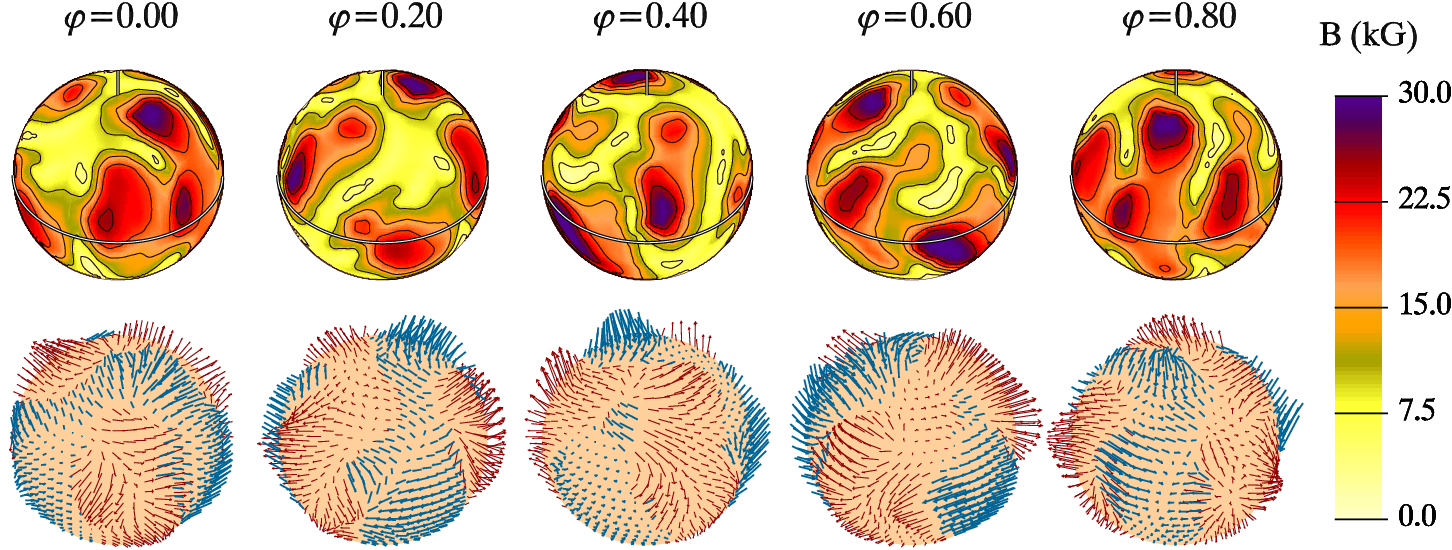
Stellar surface magnetic field topology reconstructed from time-series spectropolarimetric observations
Doppler Imaging of stellar surfaces
Doppler imaging (DI) is a powerful technique which allows deriving a two-dimensional map of stellar surface from time-series observations of the line profile variations of a rotating spotted star. DI is the most power astronomical remote sensing technique. The (indirect) resolution of the stellar surfaces provided by this method by far surpasses possibilities of the largest existing or planned interferometers. My team is one of the world's leading research groups in stellar surface imaging. I have developed tomographic mapping codes for reconstruction of- chemical and isotopic spot distributions on Ap/Bp stars
- temperature spot distributions on active late-type stars
- topologies of fossil and dynamo stellar magnetic fields
- distribution of spots and magnetic fields on tidally-distorted spectroscopic binary stars
- surface velocity field of non-radially pulsating stars
Using these inversion techniques, we have pioneered the technique of reconstruction of vector magnetic fields using spectropolarimetric observations in all four Stokes parameters for both early-type Ap stars and late-type active stars.
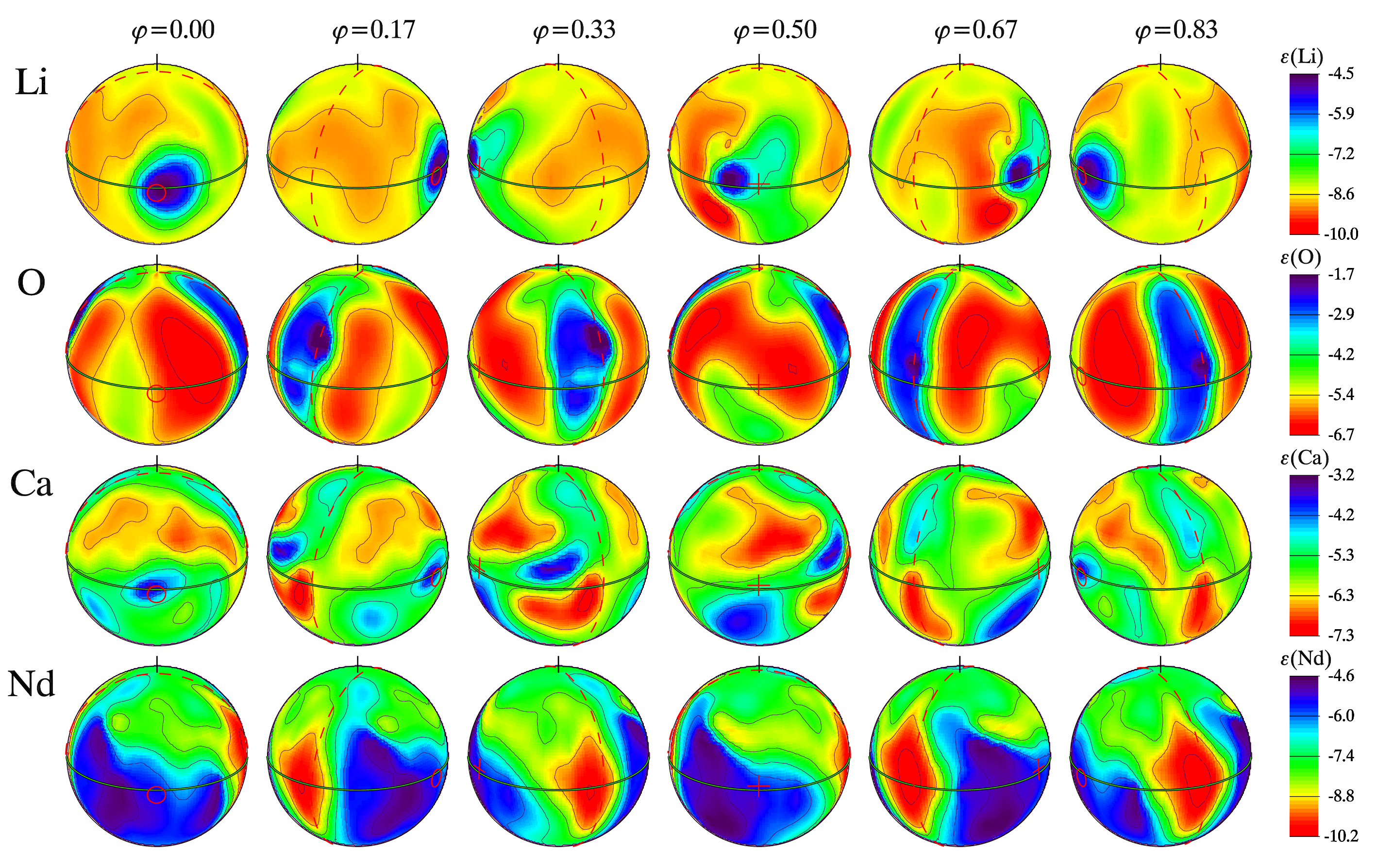
Chemical spot distribution at the surface of Ap star HR 3831
Stellar non-radial pulsations
Many stars change periodically their brightness and radius due to pulsational instability. Oscillations provide unique possibility to measure properties of the stellar interiors and determine fundamental parameters of stars using a technique known as asteroseismology.Magnetic Ap stars represent are among the most interesting targets for applications of asteroseismology. These stars exhibit non-radial p-mode oscillations with periods 4-25 minutes in the presence of highly non-uniform atmospheric chemistry and strong magnetic fields. I have pioneered spectroscopic time-resolved observations of pulsating Ap stars using large telescopes. These studies revealed a puzzling pulsational behaviour, characterized by a large diversity of radial velocity amplitudes and phase, and an unusual profile variations of the lines of rare-earth elements.
We have succeeded in interpreting and modelling pulsations in magnetic Ap stars in terms of magneto-acoustic waves, propagating outwards in stellar atmospheres with increasing amplitude and changing phase. This pulsational behaviour allows reconstructing from observations a three-dimensional picture of pulsation waves, chemical stratification, and magnetic fields, as can be done for no other star but the Sun.
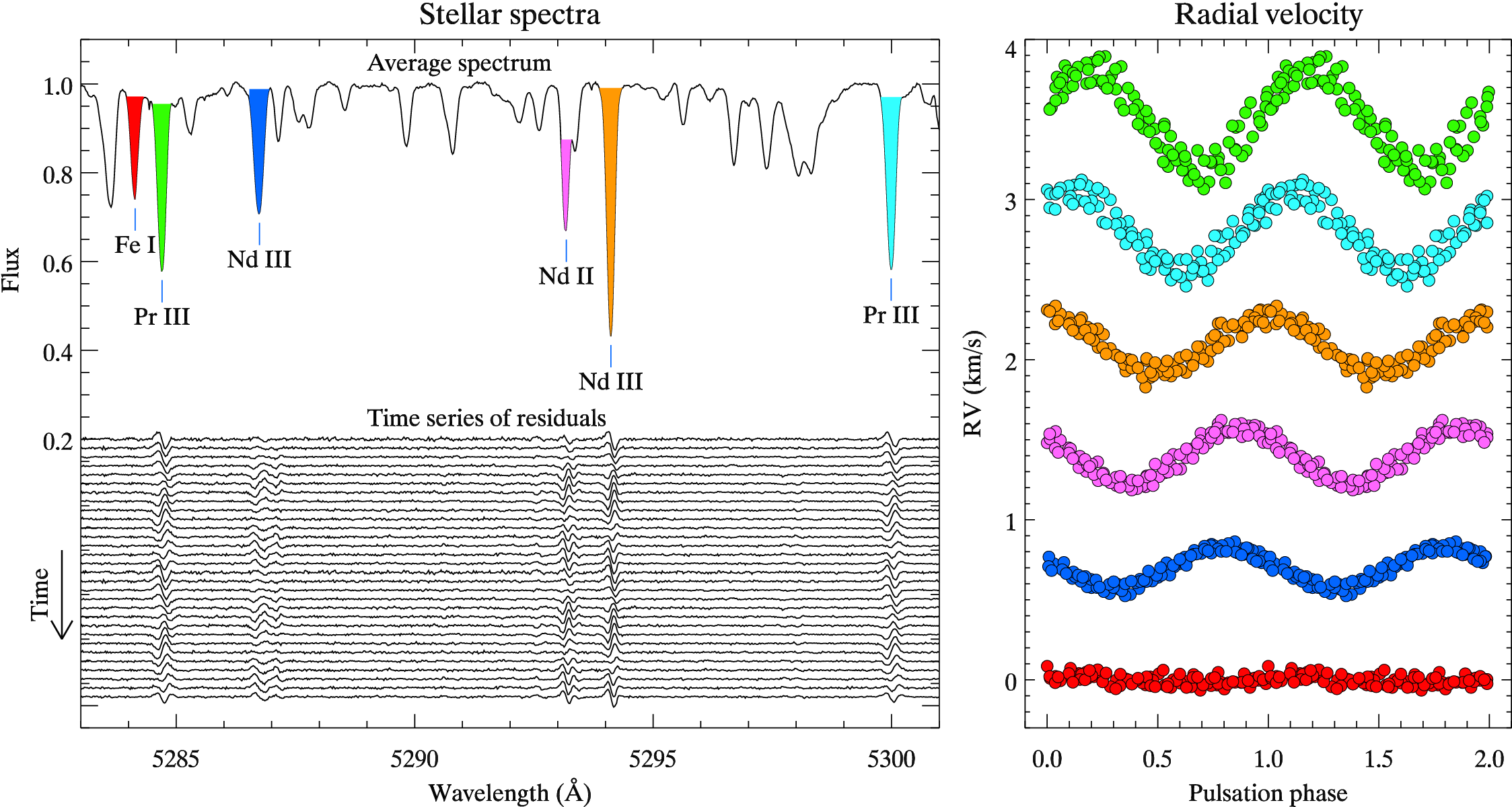
Rapid line profile variations in an oscillating Ap star
Atmospheres of early-type stars
Atmosphere is a thin outer layer of the star where radiation is formed. Models describing the temperature, pressure, and velocity distributions in stellar atmospheres are basic tools of the astronomical research on individual stars, stellar clusters and galaxies.Standard 1-D theoretical codes are available to model atmospheres of cool and hot stars, assuming solar or scaled-solar chemical composition. Such tools are not applicable to B, A, and F stars with anomalous surface abundances. In these stars line opacities differ considerably from normal stars and vary substantially from one star to another, depending on individual chemical composition and the presence of strong magnetic fields.
Together with my collaborators, I utilize an advanced opacity sampling stellar model atmosphere code LLMODELS to study effects of non-solar abundances, modification of the line opacity due to Zeeman splitting, magneto-hydrostatic equilibrium with the Lorentz force included, and an inhomogeneous vertical and horizontal distributions of chemical elements.
My theoretical work with the LLMODELS code is coupled to observational investigations using spectroscopy at large optical telescopes. These studies are aimed at finding and interpreting signatures of anomalous atmospheric structure in chemically peculiar B-F stars.
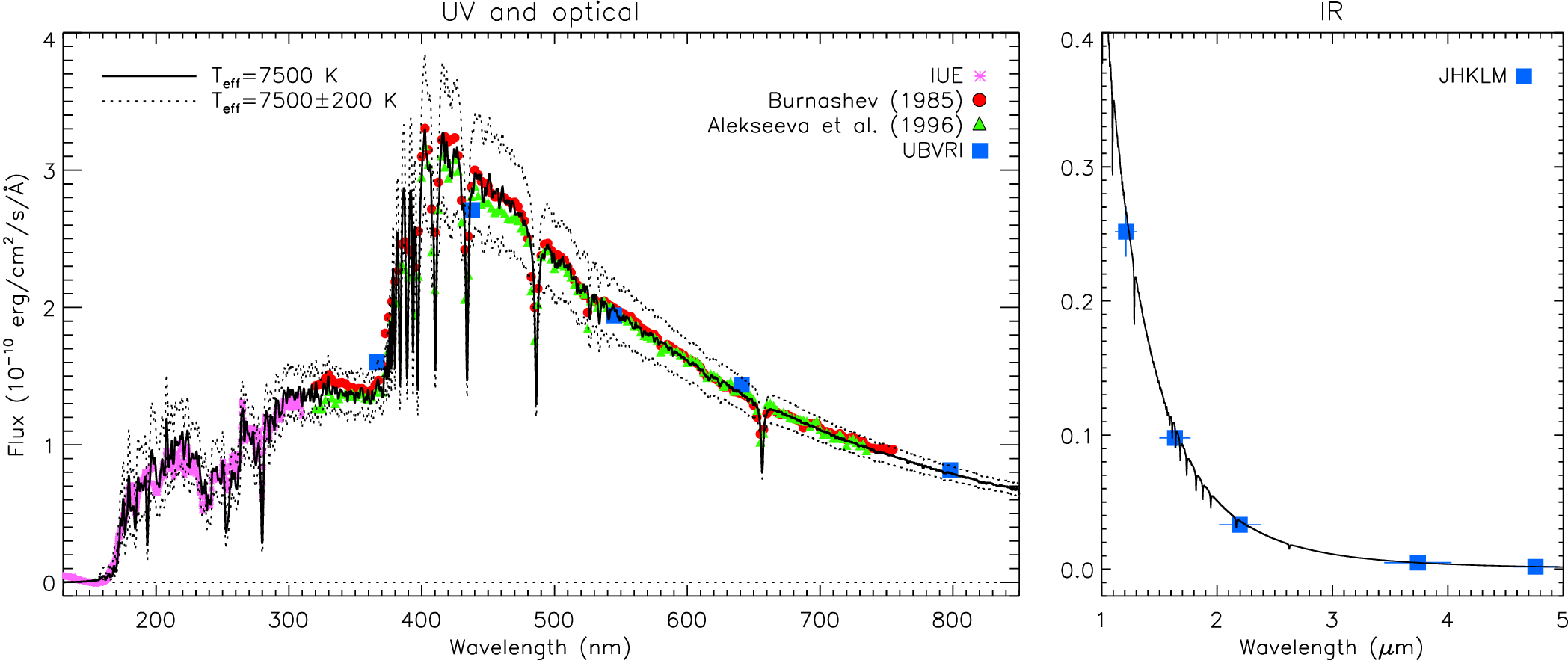
Spectral energy distribution of the cool Ap star α Cir modeled taking into account non-solar abundances and vertical stratification of chemical elements
Chemical stratification in stellar atmospheres
Stellar chemical abundance analysis is the standard tool for measuring concentrations of various elements in the atmospheres of stars of different types. Information about stellar chemistry allows astronomers to probe Galactic chemical evolution and to test different scenarios of element production by thermonuclear reactions in stellar interiors and by supernovae.The standard assumption of stellar abundance analyses is that stellar atmospheres are chemically homogeneous. Although reasonable for cool stars with convective envelopes, this may not apply to hotter stars without surface convection zones. These stars can build up considerable abundance gradients within the line forming regions due to operation of chemical transport processes.
Taking advantage of the wealth of information available in modern high-quality stellar spectroscopic observations, I have pioneered development and application of the inversion techniques to determine radial distribution of chemical elements in stellar atmospheres. My studies have added a new dimension to stellar abundance analysis, revealing vertical separation of elements in the atmospheres of chemically peculiar B-F stars.
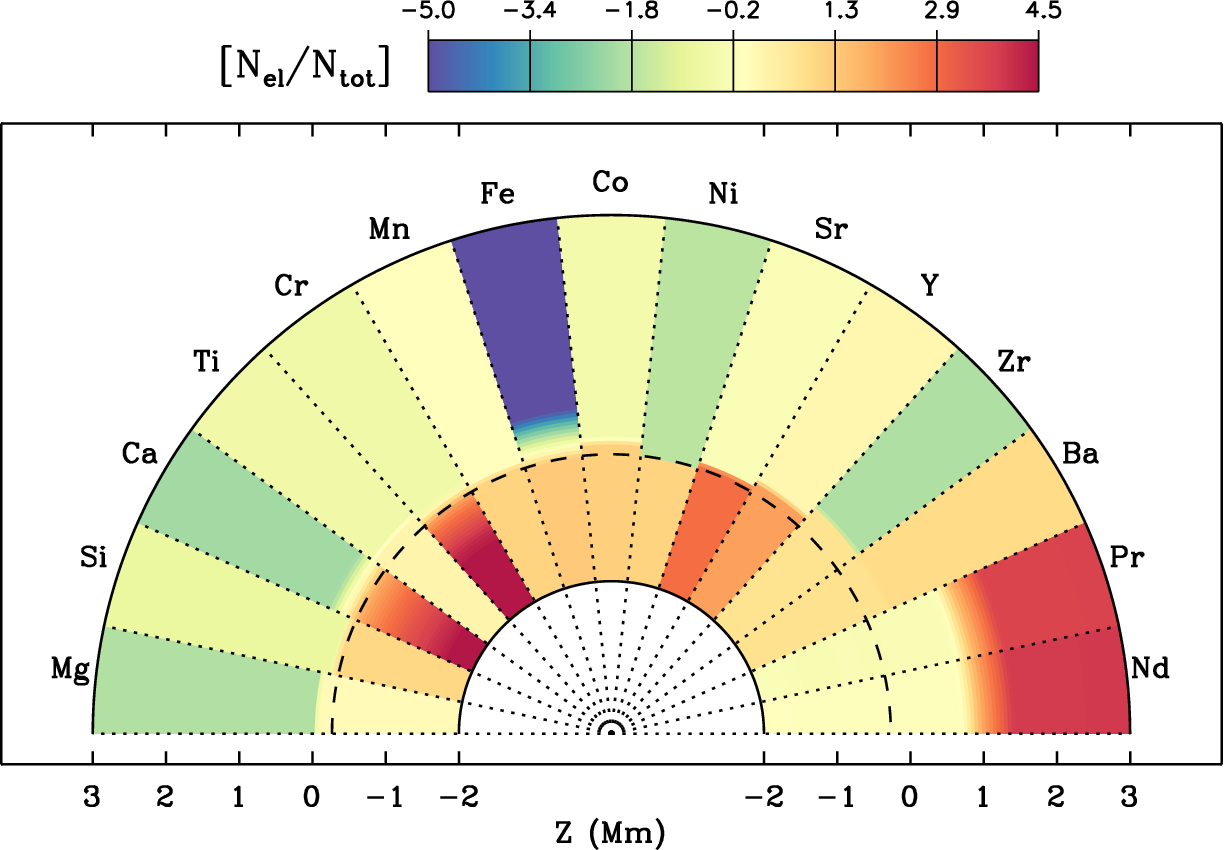
Radial distribution of chemical elements in the atmosphere of cool magnetic A star HD 24712.
Modelling spectra of binary stars
Binary stars offer unique possibilities for testing the theories of stellar structure and evolution. In particular, the masses and radii of eclipsing spectroscopic binaries can be determined completely independently of theoretical assumptions. Binaries with components of similar mass are also very useful for studying processes which affect the chemistry of stellar surface layers.I have developed codes for simulating composite spectra of multiple stars and for disentangling contributions of individual stars in time-series spectroscopic observations. These techniques are applied in the context of chemical abundance studies of early-type binary stars. A puzzling result of these studies is existence of significant difference in the chemical composition and magnetic field of close binary components with very similar fundamental parameters.
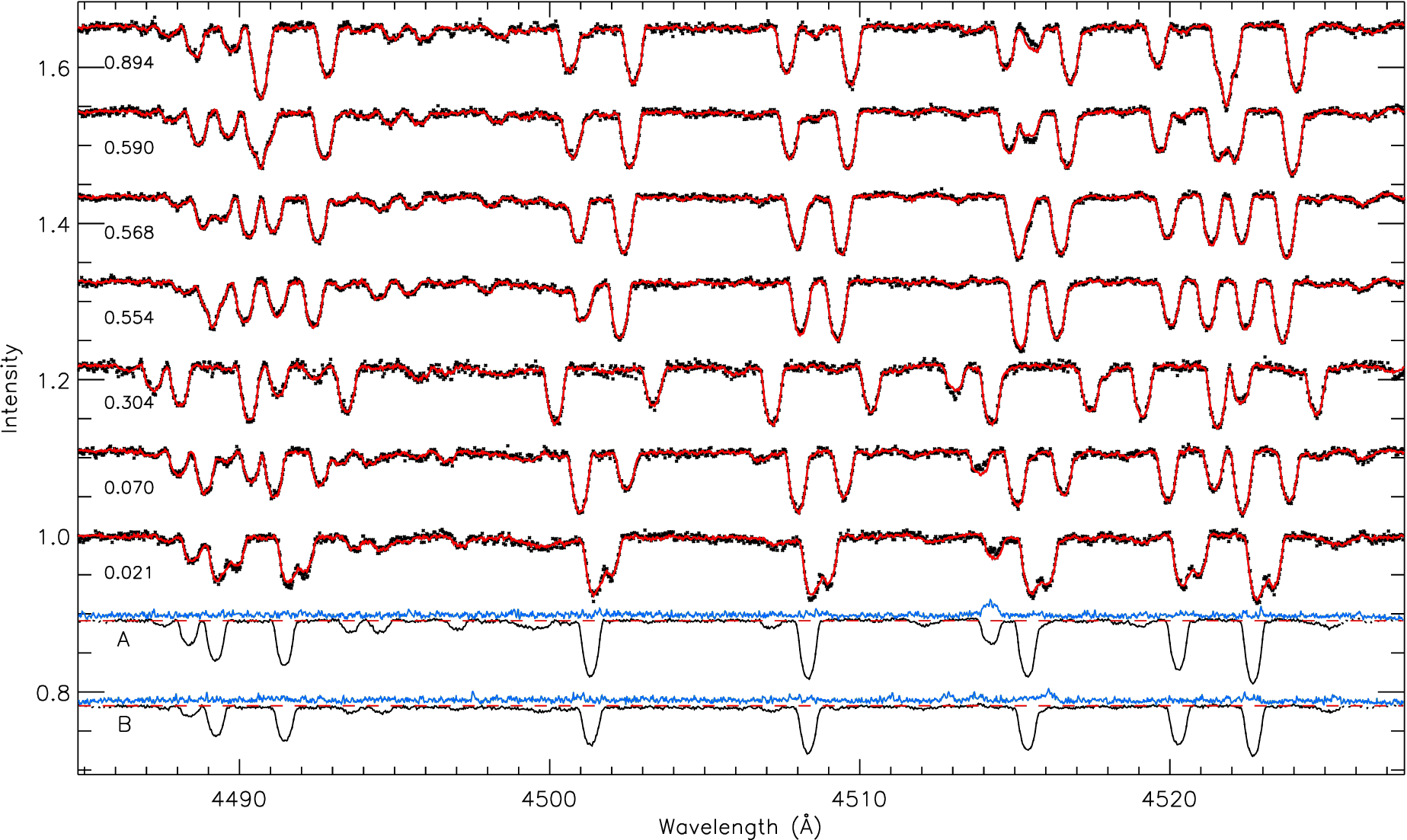
Disentangling of the composite spectra of the eclipsing binary star AR Aur
High-resolution spectroscopic and spectropolarimetric observations of stars
I use instruments at world's largest optical telescopes, such as the ESO 8-m VLT to study stars at high spectral resolution. These observational projects include studies of spots, chemical abundances and non-radial pulsations using UVES, IR spectroscopy of low-mass stars with CRIRES, and polarization measurements with FORS 1/2.I also actively use high-resolution spectropolarimeters at the 2-4-m telescopes, in particular ESPaDOnS at CFHT, NARVAL at TBL and spectrographs at NOT, to carry out investigations of stellar magnetic fields, spots and dynamical phenomena at stellar surfaces. One of the most powerful night-time four Stokes parameter spectropolarimeters, HARPSpol, was developed by Observational Astrophysics group in Uppsala for the HARPS at the ESO 3.6-m telescope. I have lead science verification and early science exploitation of this unique instrument.
Next-generation spectrographs are currently being designed for the future exteremely large ground-based telescopes, in particular the ESO ELT. I am contributing to these developments through my work for the ELT Project Science Team and participation in the ELT-HIRES consortium.
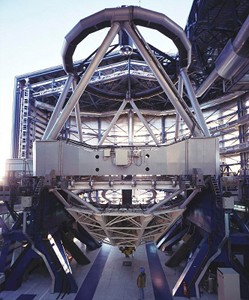 |
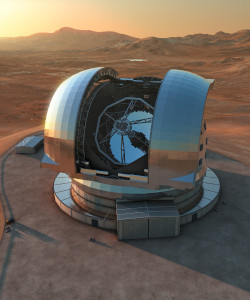 |
| ESO 8-m Very Large Telescope | Future 39-m ESO Extremely Large Telescope |
Computer programs for stellar physics research
I develop and maintain a variety of computer programs for stellar physics research. This includes codes for the visualization and analysis of spectroscopic observations, programs for calculation of theoretical stellar intensity and polarization spectra, and inversion codes for reconstruction of chemical stratification and horizontal maps of star spots and magnetic fields. Further details can be found here.I use existing and develop my own computer programs for 3-D visualization of the models of magnetic fields, non-radial pulsations, and surface inhomogeneities at the surfaces of stars.
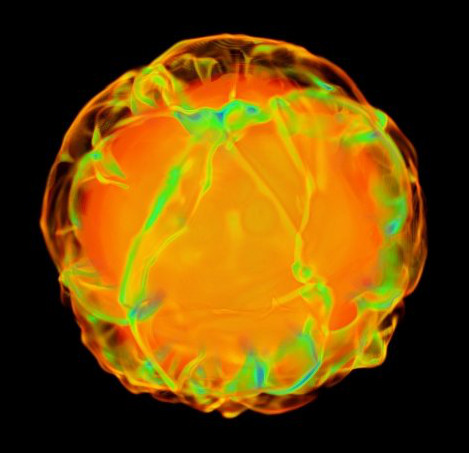 |
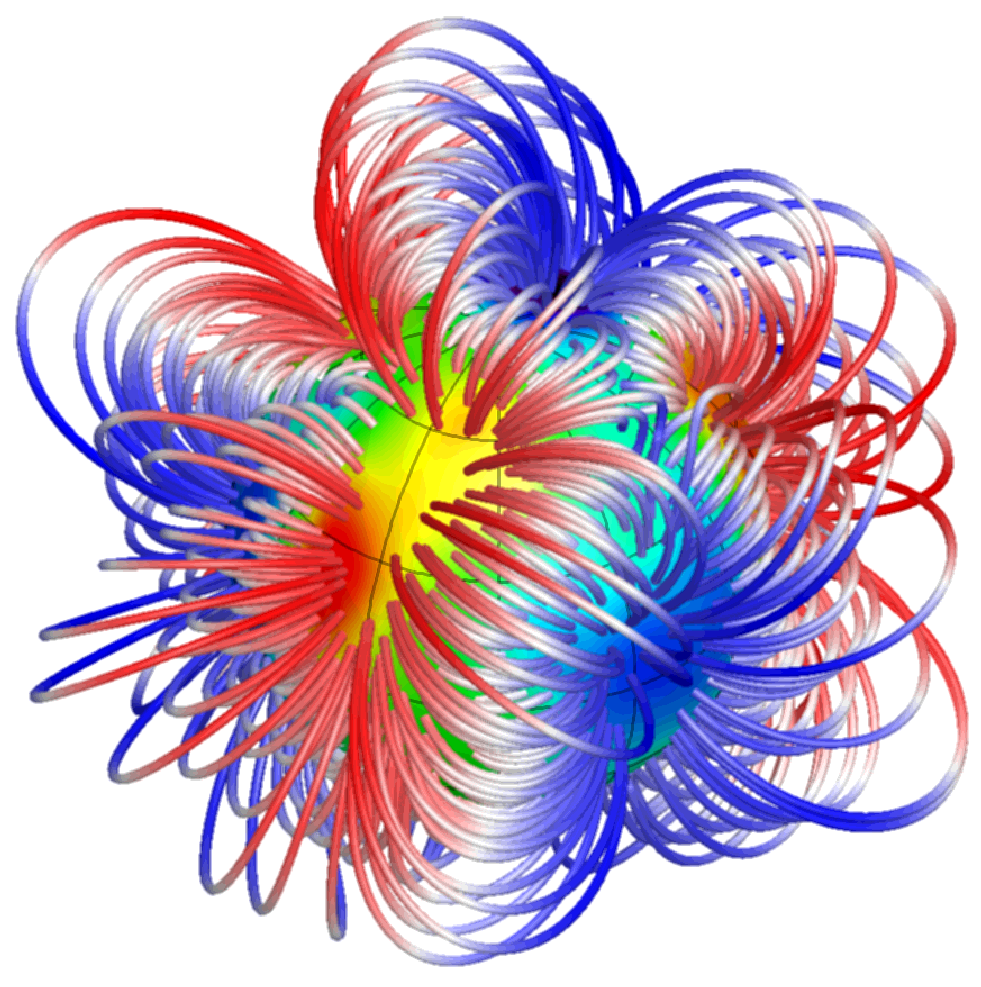 |
| Density distribution in 3-D hydrodynamic simulation of convection in red supergiant star | 3-D rendering of the magnetic field structure in the He-strong Bp star HD 37776 |